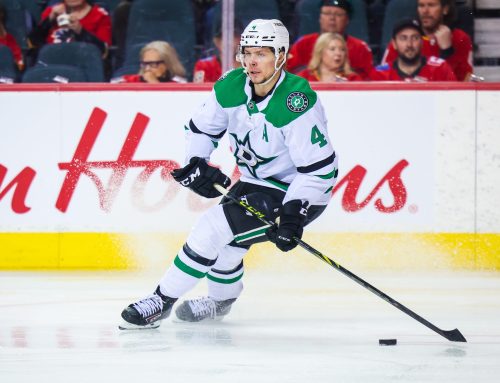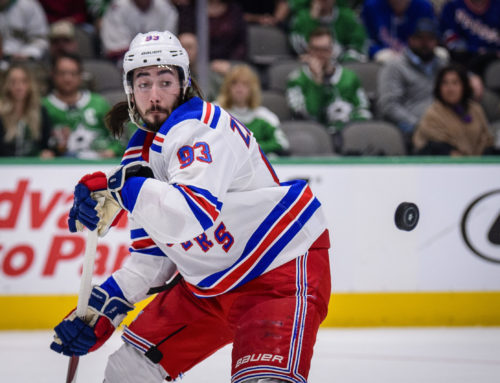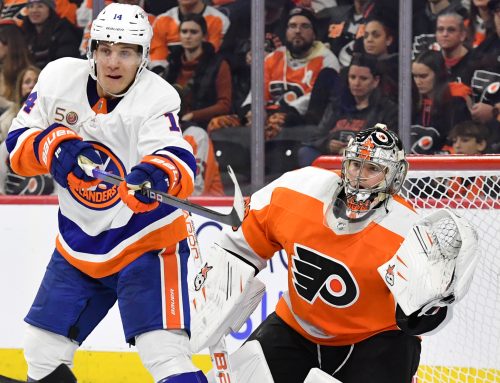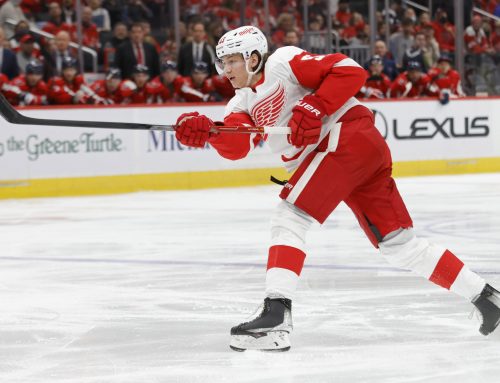Goldipucks and the Three Skaters: Batherson, Lindholm & Labanc
Rick Roos
2021-05-05
Welcome back to Goldipucks and the Three Skaters, a play on words of the Goldilocks and the Three Bears story. Here though, instead of there being three bowls of porridge, I cover three skaters and declare one too hot (i.e., doing unsustainably better than he should), another too cold (i.e., doing unsustainably worse), and a third “just right” (i.e., producing where he should be). In addition, I also assign each a rating of 1-10, indicating just how hot (rated 7-10, where 10 is the most unsustainably hot), or how cold (rated 1-4, where 1 is the most unsustainably cold), or how “just right” (rated 4-7, where 5.5 is the most “just right”) he is.
For almost half the players in the NHL, their season is nearly over. In an effort to help you not forget about them in the upcoming months, this week I'm covering three players on teams currently not in line to make the playoffs: Drake Batherson, Elias Lindholm, and Kevin Labanc. As per usual, be sure to pause for a moment before reading on, to see if you can surmise which of the three is too hot, who's too cold, and who's just right, and then find out how many you guessed correctly.
Drake Batherson (stats for him and the other players are current through May 2nd games)
After dominating at the AHL for two seasons to the tune of 62 points in 59 games during 2018-19 followed by 54 in just 44 contests in 2019-20, and looking not out of place in his NHL cameos during those two seasons (collectively 19 points in 43 games), Batherson has finally has spent an entire campaign in the NHL; and on the surface, the results have been pretty solid. The question is whether, at 22, he's just scratching the surface, or if perhaps he might follow in an unfortunately long line of players who thrived at the AHL level but could not cut it once called upon to strut their stuff with the big boys? The good news, especially if you're a Batherson owner, is data and metrics suggest he'll be a strong if not elite player in the not too distant future.
Although Batherson's 82 game season scoring pace of 51 points (via tallying 32 points in 51 games) doesn't scream star in the making, much of that is due to him not yet having gained consistency. Looking at his statistics from March 14th through April 22nd, for example, he had points in a total of just five contests out of 17, yet amassed 11 total points because in four of those games he had two points and in the other game he had three. In fact, 21 of his first 30 points came in multi-point games.
The result is Batherson has tallied at least a point in only 41% of his games this season, and the point average for the nine other forwards in the 40.0-41.5% range who've played in 45+ games is 25.5, underscoring how explosive Batherson already is and how much room for improvement he has once he gets more consistent. Lest we think Batherson can't gain consistency, we saw signs in the form of a seven-game point streak earlier in the season.
Another positive to draw from Batherson's NHL performance thus far is that his SOG rate has not only increased in each of his NHL campaigns, but by a higher amount each time, meaning the rate of growth from 2019-20 is greater than what is was from 2018-19 to 2019-20. Yes, his SOG has actually gone down as 2020-21 has progressed, yet after just one goal in his first 16 games, during which he took 38 shots, he's since potted 16 goals on 66 SOG, which means his quality of shots has likely improved, a great sign from a young player. It's a lot easier to learn to shoot more than it is to shoot better, so him having made progress on the latter is a good sign for the future.
Batherson is also doing extremely well on the man advantage, as he's received a power play point on 15 of his team's 26 PP goals. Admittedly, he's been bestowed with a ton of PP time (ranking 34th overall among NHL forwards in PP time per game); however, with the Ottawa PP converting this season on only 16.3% chances, putting it sixth worst in the NHL, his 15 PPPts is all the more impressive. In fact, excluding teammate Josh Norris, the only other forward on the teams in the bottom five in PP conversion that has even double digits in PPPts is Pavel Zacha, with exactly ten. It stands to reason that once the Ottawa's power play starts tasting more success, Batherson should be among players most in line to benefit, what with him being stapled to PP1 and Ottawa being one of those teams not afraid to give its top PP unit heavy minutes.
Batherson's strong PP scoring isn't surprising in view of his 83.3% IPP on the PP, but he also has a 74.4% IPP at ES. What this means is Batherson is finding a way to insert himself into the scoring picture. Accordingly, once Ottawa starts to score more goals, Batherson will benefit even more so than others due to being a points magnet. Also, for him to have IPPs this high despite being a winger is even more encouraging, as usually it is centers who sport higher IPPs in view of them being more likely to figure into scoring. On top of all this, Batherson has a mere 33.3% secondary assist percentage, meaning he should have lucked into even more points than he received.
Although as I noted many highly regarded prospects dominated at the AHL level but never tasted success at the NHL, signs point to Batherson not falling victim to that problem. In this, his first true NHL season, he's thriving on an anemic PP, sports very high IPPs, and has shown explosive scoring that foreshadows bigger things to come. Accordingly, Batherson's 2020-21 has been TOO COLD and he gets a rating of 2.5, suggesting he should be a 60 point player now. As for his upside, once Ottawa gets its PP on track and scores more goals in general, Batherson should be a big part of things, with point per game or better production as his realistic ceiling.
After several seasons with Carolina, where he never managed to truly break out, Lindholm was dished to the Flames as the key piece in return for Dougie Hamilton. Once in Calgary, he was inserted on the top line and paid huge dividends. Last season, however, like most other Flames Lindholm's production dropped. This season he's scoring at a rate (71 points) that's exactly between his elite 2018-19 (79) and his disappointing 2019-20 (63); and from what I can see that's right around what we should expect from him going forward.
Lindholm's ice times have been quite consistent during his Calgary tenure, as have his SOG rates. In fact, one clue that his 2018-19 total might have been inflated was his SOG rate, as among the 12 wingers – and he was playing wing almost exclusively that season – who had more points that season than his 78, his 178 SOG was easily the lowest, with only two of the other 12 being below 200 and the average being 243, or 36% higher than his SOG total. On top of that, his shooting percentage in 2018-19 was above his career rate. Essentially there were two factors that led to him scoring more than he "deserved" in 2018-19.
One area where Lindholm has excelled is on the PP. His cumulative PPPts since becoming a Flame rank him in the top 25 among all forwards and more than a third of his points while in Calgary have come with the man advantage. Great right? Maybe not…
Although the most elite NHL players tally just as a high – or even higher – of a percentage of their points on the PP, they also manage to score a lot at ES. In fact, of those who have more PPPts than Lindholm since he came to Calgary, his overall points per game rate ranks him in the bottom five, with two other center-wingers in J.T. Miller and Ryan-Nugent Hopkins, plus two wingers in Mike Hoffman and Phil Kessel. And looking at the scoring rates of all four this season, only Miller is in the same ballpark as Lindholm. Although success on the PP is indeed important in order to thrive in fantasy, it's not a surefire ticket to elite production, as we can see from these comparables.
Looking at his other metrics, Lindholm's overall IPP, at 70.5%, is his highest since becoming a Flame, besting his 62.8% IPP from 2019-20 and 61.9% IPP from 2018-19. That's should not come as a surprise, as this season he's spent the most time apart from Johnny Gaudreau and/or Sean Monahan, and instead played with forwards who, on paper, are less talented than those two. While it should lead to a higher IPP for Lindholm, there are fewer goals being scored overall, particularly with his demonstrated lack of ability to produce well at even strength.
Additionally, Lindholm's secondary assist percentage is his highest as a Flame at 57.7%. But he's actually ran high in that area, with rates of 44.0% and 49.0% in his prior two seasons, and those were when he was primarily a winger. A rate above 50% now that he's almost exclusively a center seems not too unreasonable. In short, these factors likely balance either other out for no net scoring gain or loss.
Lindholm's points per 60 rate of 2.6 is exactly in the middle of his two prior seasons as a Flame (2.9 in 2018-19, and 2.3 last season), suggesting that's where it should be. Also, his offensive zone starting percentage is lower this season, as would be expected due to being separated more from Johnny Gaudreau, whom the Flames have no choice but to give favorable deployment. Perhaps his OZ% could see a bit of an increase in the normal course; however, any gains made there likely would be offset by other factors, such as his secondary assists rate drifting closer to normal rates.
If you own Lindholm in fantasy leagues you're probably hoping for a return to what you saw from him in 2018-19. I'm here to tell you not to hold your breath, as that seemed to be an outlying season from a player who relies heavily on PP scoring but doesn't seem too adept at producing points at even strength and whose metrics for this season suggest it could be his new normal. As such, it's best to expect Lindholm to be at or near the scoring pace he's shown this season, meaning his production for 2020-21 has been JUST RIGHT and he gets a rating of 5.75.
After starring in the OHL and then playing point per game hockey in the AHL, Labanc gained a ticket to the NHL, where his scoring rate increased until 2018-19, when, to the surprise of many, he exploded with 56 points despite only 14:01 of ice time per game. He famously gambled on himself by signing a one-year deal, only to see his total drop to 33 points in 70 games. This season he's played a bit better, but still below expectations and barely above a point per every other game. Still only 25, and on a team that needs all the scoring it can get, things can only improve/rebound for Labanc, right? Not from where I sit.
Let's focus first on Labanc's production in 2018-19, when he posted 56 points, with 20 on the PP, in 82 games despite 136 SOG. If those seem like outlying statistics it's because they are. Going back to 2000-01 only 25 other players had 60 or fewer points despite 20+ PPPts and 140 or fewer SOG in 75+ games. Looking at the list of players, we see veterans in the twilight of their careers (Ron Francis in 2003-04, Mikko Koivu in 2016-17, Steve Sullivan In 2011-12, Doug Weight in 2006-07, Rod Brind'Amour in 2008-09, Marty MacInnis in 2000-01, Scott Mellanby in 2002-03) as well as a good number of players who never subsequently equaled their point total from that particular season (Espen Knutsen in 2001-02, Tomas Holmstrom in 2005-06, Michael Handzus in 2003-04, Mark Parrish in 2003-04, David Desharnais in 2011-12, Alexei Morozov in 2003-04, Jim Dowd in 2001-02, Alexander Wennberg in 2016-17). Even players who went on to have greater success in one or more subsequent seasons differ from Labanc in that they met the criteria when older than him (Valteri Filppula in 2013-14, Andrew Brunette in 2000-01) or didn't have down seasons immediately afterwards (Mike Ribeiro in 2005-06, Jusse Jokinen in 2005-06, Pierre-Marc Bouchard in 2005-06, Marcus Johanssen in 2011-12, J.T. Miller in 2018-19). In fact, the only player who did so while young, had down seasons, then rebounded, was Kyle Wellwood, and his rebound season saw him post only 47 points and he was out of the NHL by age 30. Long story short, the metrics of Labanc's breakout season, combined with his failure to immediately build upon that success, does not bode well for his future.
One of the keys to his performance that season was obviously his production on the PP. Since then, however, he's maintained the same PP time per game yet seen his production crater last season to just nine PPPts in 70 games and this season with a measly three PPPts. His IPP on the PP was 71.4% in 2018-19, but it dropped to 50.0% last season and stands at only 37.5% for 2020-21. In fact, despite Labanc ranking 102nd among forwards in total PPTOI for the season, his three PPPts ties him for 184th. Although San Jose doesn't have a wealth of options for PP scoring, Labanc might soon find himself losing PP time in favor of players like Timo Meier and Ryan Donato, who have ten and six PPPts respectively despite logging 25% fewer PP minutes. Even if he keeps his plum PP spot, it's becoming clearer by the day that Labanc is not the PP whiz he was in 2018-19, thus making it more difficult to envision him seeing his point total rebound.
Ironically, as Labanc has shot the puck more over the past two seasons his scoring has not been able to approach what it was in 2018-19, this despite two minutes more ice time last season than in 2018-19 and more this season versus last. Part of that is likely due to his overall IPP, which has been a not very good 60.5% this season and was 61% in 2019-20.
San Jose seems to be losing patience with him, as Labanc's most frequent linemates through the first three quarters were Logan Couture and Evander Kane, two of the teams best three forwards, whereas thus far in Q4 he has been taking the ice primarily with the slumping Timo Meier and Dylan Gambrell. The result has been him shooting and scoring less, likely underscoring that Labanc is a player who needs to be carried by others in order to produce. With San Jose seemingly no longer content for that to occur, his production is due to suffer.
On the plus side, the Sharks are bad enough that Labanc is all but assured not to be taken out of the top-nine picture… for now. However, this is also a team with six forwards within the top 100 of the Top 200 Prospect Forwards, meaning there will soon be others ready to step in and likely displace the poorly performing Labanc.
Those who are clinging to hope that Labanc can replicate, let alone best, what he did in 2018-19 should resign themselves to the fact that he over-performed that season, both in terms of the numbers and the player comparables. Since then he's shown his true colors, those of a complimentary player in whom San Jose – who have many top prospects waiting in the wings – appear to be losing patience. Labanc seems like he's not even a point per every other game player, and thus his 2020-21 has been TOO HOT, with his rating being a 7.5. Best not to waste a keeper spot on him even in the deepest of leagues, as he's not a good bet to hit even 40 points again in a full season.
************
Questions for Mailbag My monthly mailbag is a few weeks away but already starting to fill. To get your question(s) to me, you can either (1) private message “rizzeedizzee” via the DobberHockey Forums or, instead, (2) email [email protected] with “Roos Mailbag” as the subject line.





 BUF
BUF N.J
N.J PHI
PHI MIN
MIN FLA
FLA WPG
WPG VAN
VAN TOR
TOR CGY
CGY ARI
ARI